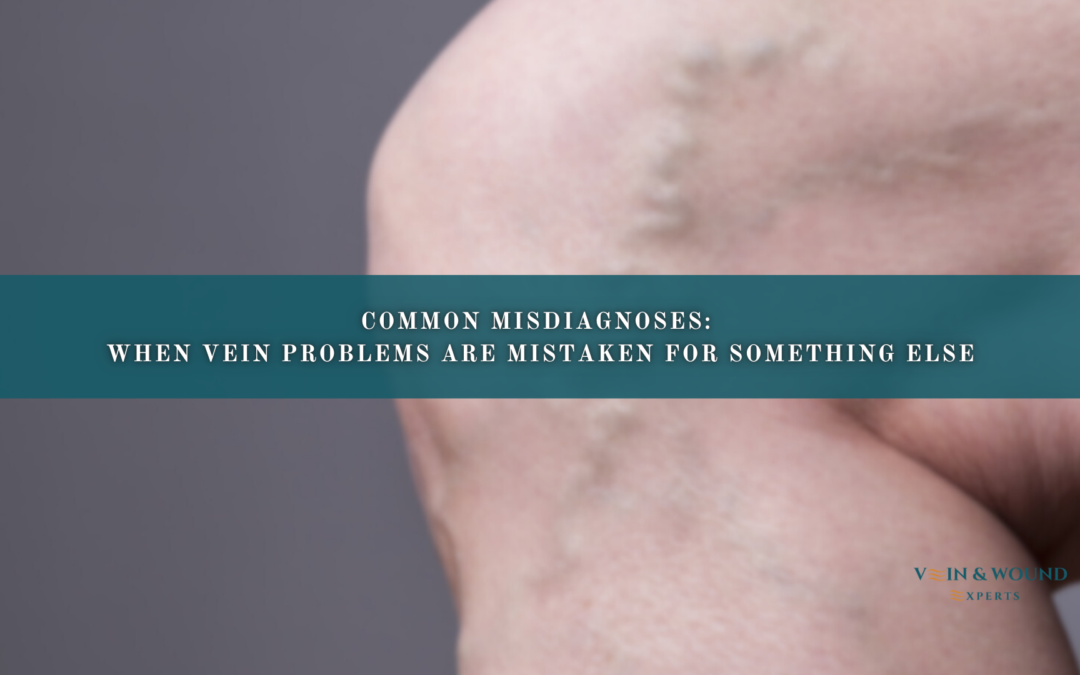When Vein Issues Are Misdiagnosed
Vein problems are often overlooked and misdiagnosed, leading to unnecessary discomfort and untreated conditions. Misdiagnosing vein issues is common, as the symptoms often resemble those of other conditions. For many, the signs of poor circulation or vein issues are misinterpreted as something else, delaying the appropriate treatment.
1. What Is Misdiagnosed Vein Disease? 💡

Misdiagnosis of vein issues occurs when symptoms like swelling, pain, and visible veins are mistaken for other conditions. These symptoms can easily be confused with chronic leg pain causes, such as muscle strain or injury. In some instances, vein problems are wrongly attributed to arthritis or other joint-related conditions. This misdiagnosis can delay appropriate treatment, allowing symptoms to worsen.
2. How Vein Pain Is Often Misdiagnosed 🦵
Vein pain misdiagnosis is common because the symptoms can be similar to those of other medical conditions. For instance, chronic leg pain can stem from joint issues to muscle spasms, making it easy to confuse these with pain caused by vein problems. Swelling in the legs, for example, might be mistakenly attributed to arthritis or even general fatigue, while it may actually be caused by poor blood circulation in the veins. Without a proper diagnosis, vein problems like varicose veins or chronic venous insufficiency may go untreated, leading to more serious complications.
3. When Vein Problems Are Mistaken for Arthritis 💔
In many cases, vein problems mistaken for arthritis is a common issue, especially in older adults. The pain, swelling, and discomfort in the legs or joints can lead people to believe they have arthritis, as both conditions share similar symptoms. However, arthritis typically affects the joints, while vein problems stem from issues with the blood flow in the veins. Misdiagnosing vein issues as arthritis can delay appropriate treatment, causing unnecessary pain and affecting mobility.
4. Why Early Diagnosis Is Crucial 🔍
Early detection and diagnosis of vein issues are critical to preventing further complications. If vein issues are not correctly diagnosed, they can lead to chronic conditions such as chronic venous insufficiency, ulcers, and even blood clots. By understanding the signs of vein problems and how they differ from other conditions, patients can avoid misdiagnosis and receive the proper treatment. Misdiagnosed vein pain can often be identified with a simple ultrasound, allowing doctors to examine blood flow and determine if the issue is related to the veins or another condition.
5. Symptoms to Look Out For 🧠
If you’re experiencing chronic leg pain, look for these signs that might indicate vein issues rather than other conditions like arthritis or muscle strain:
-
Swelling in the legs that worsens after long periods of standing
-
Visible veins, such as varicose veins or spider veins
-
Aching or heaviness in the legs
-
Skin discoloration or changes in texture around the ankles or lower legs
-
Cramps or restless legs at night
By recognizing these symptoms, you can better identify whether your pain is related to vein problems, leading to more accurate diagnosis and treatment.
6. How to Ensure You Get the Right Diagnosis 💬
To avoid misdiagnosing vein pain, it’s essential to ask the right questions during your consultation. Some helpful questions include:
-
What diagnostic tests are being used to determine the cause of my leg pain?
-
Could my symptoms be related to a vein issue like chronic venous insufficiency or another vein condition?
-
How will the treatment differ if my pain is caused by a vein problem versus arthritis or other conditions?
By asking these questions, you ensure that the right tests are performed, and you get the appropriate treatment for your condition.
7. When to Seek Specialist Help 🩺
If you’re dealing with chronic leg pain or vein issues that may be confused with arthritis, it’s time to see a specialist who can accurately diagnose the cause of your symptoms. A vein specialist or a vascular doctor can provide the most effective treatment for vein-related conditions, and they’ll use the latest diagnostic methods, such as ultrasound imaging, to confirm the source of the pain.
If left untreated, vein issues can lead to severe complications, including chronic venous insufficiency and blood clots, which can significantly impact quality of life.
Andy Sharify
Position

